Chapter : Communication PPT,Semester,Engineering – Electronics and Communication Engineering (ECE)
Communications
•Contents
–Introduction to Communication Systems
–Analogue Modulation
AM, DSBSC, VSB, SSB, FM, PM, Narrow band FM, PLL Demodulators, and FLL Loops
–Sampling Systems
Time and Frequency Division multiplexing systems, Nyquist Principle, PAM, PPM, and PWM.
–Principles of Noise
Random variables, White Noise, Shot, Thermal and Flicker Noise, Noise in cascade amplifiers
–Pulse Code Modulation
PCM and its derivatives, Quantising Noise, and Examples
–Digital Communication Techniques
ASK, FSK, PSK, QPSK, QAM, and M-ary QAM.
–Case Studies
Spread Spectrum Systems, Mobile radio concepts, GSM and Multiple Access Schemes Mobile radio
Communications ———————————————————————————————————— Next Slide
Recommended Text Books
•“An introduction to Analogue and Digital communication”, Haykin (Wiley)
•“Communication Systems”, Carlson (McGraw & Hill)
•“Information, Transmission, Modulation and Noise”, Schwartz (McGraw & Hill)
•“Analogue and Digital Communication Systems”, Raden (Prentice-Hall)
•“Communication Systems”, Haykin (Wiley)
•“Electronic Communication Techniques”, Young (Merril-Publ)
Communications ———————————————————————————————————— Next Slide
Introduction to Modulation and Demodulation
The purpose of a communication system is to transfer information from a source to a destination.
In practice, problems arise in baseband transmissions, the major cases being:
• Noise in the system – external noise and circuit noise reduces the signal-to-noise (S/N) ratio at the receiver (Rx) input and hence reduces the quality of the output.
• Such a system is not able to fully utilise the available bandwidth, for example telephone quality speech has a bandwidth ≃ 3kHz, a co-axial cable has a bandwidth of 100’s of Mhz.
• Radio systems operating at baseband frequencies are very difficult.
• Not easy to network.

Communications ———————————————————————————————————— Next Slide
Multiplexing
Multiplexing is a modulation method which improves channel bandwidth utilisation. For example, a co-axial cable has a bandwidth of 100’s of Mhz. Baseband speech is
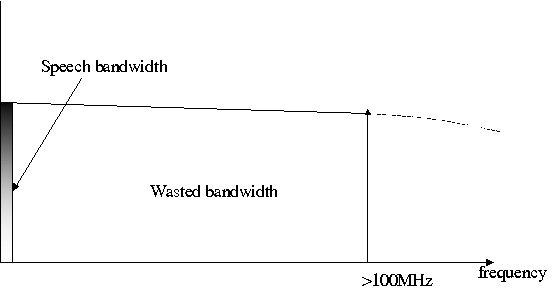
Communications ———————————————————————————————————— Next Slide
1) Frequency Division Multiplexing FDM
This allows several ‘messages’ to be translated from baseband, where they are all in the same frequency band, to adjacent but non overlapping parts of the spectrum.
An example of FDM is broadcast radio (long wave LW, medium wave MW, etc.)

Communications ———————————————————————————————————— Next Slide
2) Time Division Multiplexing TDM
TDM is another form of multiplexing based on sampling which is a modulation technique. In TDM, samples of several analogue message symbols, each one sampled in turn, are transmitted in a sequence, i.e. the samples occupy adjacent time slots.
Communications ———————————————————————————————————— Next Slide
Radio Transmission
•Aerial dimensions are of the same order as the wavelength, , of the signal
(e.g. quarter wave /4, /2 dipoles).
is related to frequency by
λ= where c is the velocity of an electromagnetic wave, and c =
3×108 m/sec in free space.
For baseband speech, with a signal at 3kHz, (3x103Hz)
λ= = 105 metres or 100km.
• Aerials of this size are impractical although some transmissions at Very Low Frequency (VLF) for specialist
applications are made.
• A modulation process described as ‘up-conversion’ (similar to FDM) allows the baseband signal to be
translated to higher ‘radio’ frequencies.
• Generally ‘low’ radio frequencies ‘bounce’ off the ionosphere and travel long distances around the earth,
high radio frequencies penetrate the ionosphere and make space communications possible.
The ability to ‘up convert’ baseband signals has implications on aerial dimensions and design, long distance
terrestrial communications, space communications and satellite communications. Background ‘radio’ noise
is also an important factor to be considered.
• In a similar content, optical (fibre optic) communications is made possible by a modulation process in which
an optical light source is modulated by an information source.
Communications ———————————————————————————————————— Next Slide
Networks
•A baseband system which is essentially point-to-point could be operated in a network. Some forms of access control (multiplexing) would be desirable otherwise the performance would be limited. Analogue communications networks have been in existence for a long time, for example speech radio networks for ambulance, fire brigade, police authorities etc.
•For example, ‘digital speech’ communications, in which the analogue speech signal is converted to a digital signal via an analogue-to-digital converter give a form more convenient for transmission and processing.
Communications ———————————————————————————————————— Next Slide
What is Modulation?
In modulation, a message signal, which contains the information is used to control the parameters of a carrier signal, so as to impress the information onto the carrier.
The Messages
The message or modulating signal may be either:
analogue – denoted by m(t)
digital – denoted by d(t) – i.e. sequences of 1’s and 0’s
The message signal could also be a multilevel signal, rather than binary; this is not
considered further at this stage.
The Carrier
The carrier could be a ‘sine wave’ or a ‘pulse train’.
Consider a ‘sine wave’ carrier:
• If the message signal m(t) controls amplitude – gives AMPLITUDE MODULATION AM
• If the message signal m(t) controls frequency – gives FREQUENCY MODULATION FM
• If the message signal m(t) controls phase- gives PHASE MODULATION PM or M
Communications ———————————————————————————————————— Next Slide
• Considering now a digital message d(t): If the message d(t) controls amplitude – gives AMPLITUDE SHIFT KEYING ASK. As a special case it also gives a form of Phase Shift Keying (PSK) called PHASE REVERSAL KEYING PRK.
• If the message d(t) controls frequency – gives FREQUENCY SHIFT KEYING FSK.
• If the message d(t) controls phase – gives PHASE SHIFT KEYING PSK.
• In this discussion, d(t) is a binary or 2 level signal representing 1’s and 0’s

Communications ———————————————————————————————————— Next Slide
Multi-Level Message Signals
As has been noted, the message signal need not be either analogue (continuous) or binary, 2 level. A message signal could be multi-level or m levels where each level would represent a discrete pattern of ‘information’ bits. For example, m = 4 levels
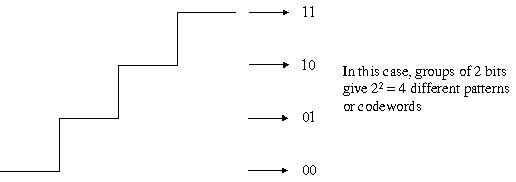
Communications ———————————————————————————————————— Next Slide
• In general n bits per codeword will give 2n = m different patterns or levels.
• Such signals are often called m-ary (compare with binary).
• Thus, with m = 4 levels applied to: Amplitude gives 4ASK or m-ary ASK Frequency gives 4FSK or m-ary FSK Phase gives 4PSK or m-ary PSK
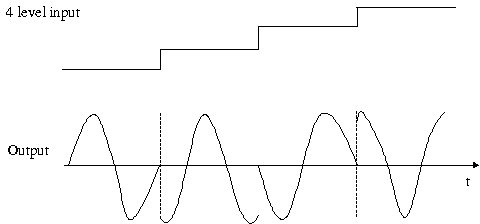
Communications ———————————————————————————————————— Next Slide
Consider Now A Pulse Train Carrier
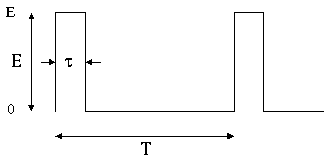
The 3 parameters in the case are:
Pulse Amplitude E
Pulse width vt
Pulse position T
Hence:
• If m(t) controls E – gives PULSE AMPLITUDE MODULATION PAM
• If m(t) controls t – gives PULSE WIDTH MODULATION PWM
• If m(t) controls T – gives PULSE POSITION MODULATION PPM
In principle, a digital message d(t) could be applied but this will not be considered further.
Communications ———————————————————————————————————— Next Slide
What is Demodulation?
Demodulation is the reverse process (to modulation) to recover the message signal m(t) or d(t) at the receiver.

Communications ———————————————————————————————————— Next Slide
Summary of Modulation Techniques 1
Communications ———————————————————————————————————— Next Slide
Summary of Modulation Techniques 2
Communications ———————————————————————————————————— Next Slide
Summary of Modulation Techniques with some Derivatives and Familiar Applications
Communications ———————————————————————————————————— Next Slide
Summary of Modulation Techniques with some Derivatives and Familiar Applications
Communications ———————————————————————————————————— Next Slide
Modulation Types AM, FM, PAM
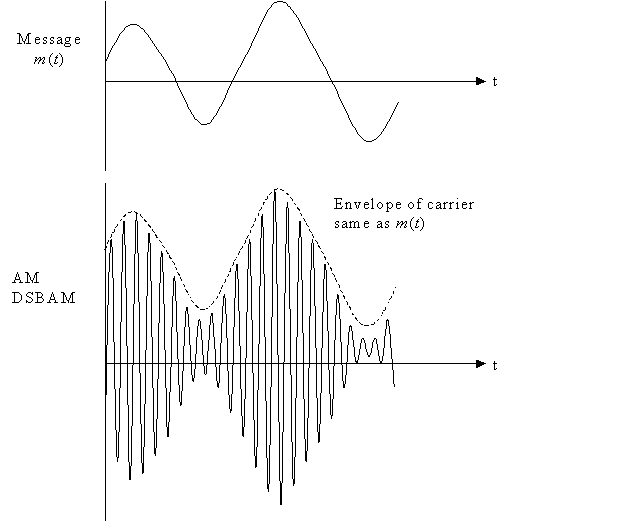
Communications ———————————————————————————————————— Next Slide
Modulation Types AM, FM, PAM 2
Communications ———————————————————————————————————— Next Slide
Modulation Types (Binary ASK, FSK, PSK)
Communications ———————————————————————————————————— Next Slide
Modulation Types (Binary ASK, FSK, PSK) 2
Communications ———————————————————————————————————— Next Slide
Modulation Types – 4 Level ASK, FSK, PSK
Communications ———————————————————————————————————— Next Slide
Modulation Types – 4 Level ASK, FSK, PSK 2
Communications ———————————————————————————————————— Next Slide
Analogue Modulation – Amplitude Modulation
vc(t) = Vc cos(ct), peak amplitude = Vc, carrier frequency c radians per second. Since c = 2fc, frequency = fc Hz where fc = 1/T.
Consider a ‘sine wave’ carrier
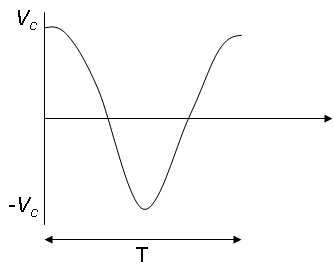
Communications ———————————————————————————————————— Next Slide
Message Signal m(t)
In general m(t) will be a band of signals, for example speech or video signals. A notation or convention to show baseband signals for m(t) is shown below











